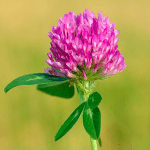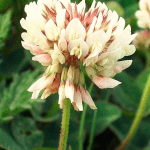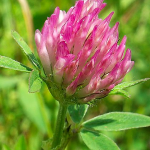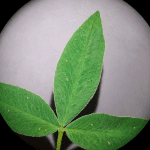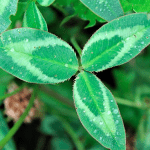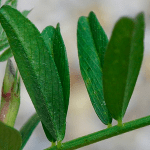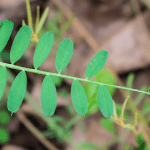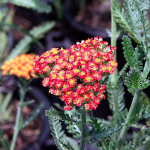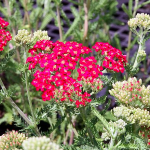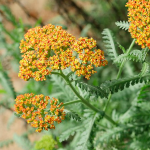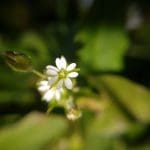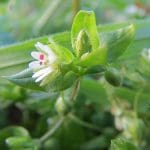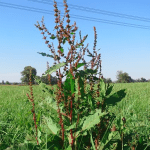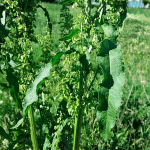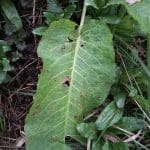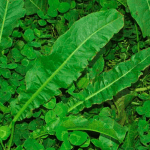Through this piece we’re going to be looking at some of the most common & best things to look for when foraging in fields.
If you’re someone who loves the great outdoors, exploring new places, and discovering new things, then you’re in for a treat. Foraging is a fun and fulfilling activity that has been enjoyed by humans for thousands of years. It involves searching for and gathering wild, edible plants, berries, and nuts from their natural habitats.
Foraging in fields can be an especially rewarding experience, as there is an abundance of plant life to discover and explore. You might be surprised at the variety of edible plants that can be found in fields, including dandelion greens, wild berries, mushrooms, and even some herbs. The best part is that foraging is not only a fun adventure, but it can also be a great way to save money and enjoy fresh, natural foods.
In today’s world, where many people are looking for ways to live a more sustainable and self-sufficient lifestyle, foraging can be a wonderful way to connect with nature and learn more about the environment around us. Whether you’re a seasoned forager or just getting started, there’s always something new to discover in the great outdoors. So, let’s head out to the fields and see what we can find!
What can we find when Foraging in Fields
Clover/Edible/Spring/Summer/Autumn
Red Clover White Clover Zigzag Clover
There are three different species of what most people would term Clover that are prolific and native to our fields and meadows. Red Clover (Trifolium pratense), White Clover (Trifolium repens) and Zigzag Clover (Trifolium medium).
These three plants are easy to identify. The Latin for their genus gives a big clue, Trifolium translating as “three leaves”. All members of this genus have three leaves attached to the top of a stalk.
Red and Zigzag Clover are upright and sightly straggling, with Red Clover being a bit taller, Zig Zag is usually about 50cm in height, Red is about 60cm. Red and Zigzag both have red to pink flowers and both are pubescent, although Red Clover is hairier. The easiest way to tell the difference between these two is to look at the leaves. Zigzag Clover has much narrower leaves than Red Clover, 10-15mm. The leaves of Red Clover are more obviously rounded, with an inverted white V-shape, 10-30mm.
Zigzag Clover Leaves Red Clover Leaves
White Clover has, as the name alludes to, white flowers and is a creeping perennial with rooting nodes, preferring to stay close to the ground. Like Red Clover, White Clover has the same inverted V-shaped mark on it’s leaves, which are 10-25mm and looks very similar to the leaves of Red Clover when they are both immature. The easiest way to distinguish between the two is to check if the leaves are slightly hairy. If they are, then you are looking at Red Clover not White Clover.
White Clover Leaves

The leaves and flowers of all three of these Trifolium spp. Are edible and make a nice addition to salads. You can also make blossom jam with them and tea.
Red Clover is often used in herbal tea blends for treating the symptoms of the menopause, as it contains phytoestrogens. It is also prescribed for lowering cholesterol and to treat osteoporosis.
White Clover was traditionally taken to purify and cleanse the blood.
All three species are nutrient dense, with high mineral content and are alterative, helping restore strength after periods of illness.
It’s not advisable to consume Red Clover if pregnant or breastfeeding.
Ribwort Plantain/Edible/Spring/Summer/Autumn
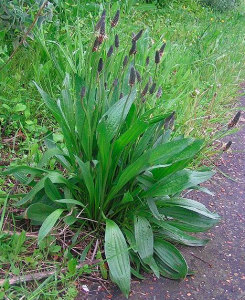
The Latin name for this plant is Plantago lanceolata. Plantago translates to “sole of the foot” which refers to the fact that the leaves are often found growing very close to the ground. Lanceolata translates to “spear” or “lance” and refers to the shape of the leaves which are long and thin with a pointed tip.
The leaves grow in a basal rosette, have ribbed veins running along the length of the leaf and are long and thin (narrowly ovate) 10-15cm long.
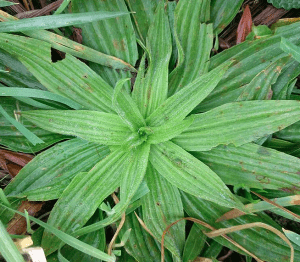
The flower inflorescence is on a single stalk that is deeply furrowed, growing from the centre of the leaf rosette, 10-15 cm high. The flowers are 4mm and the calyx is green brownish, with 4 bent back lobes with brown midribs and long white stamens.
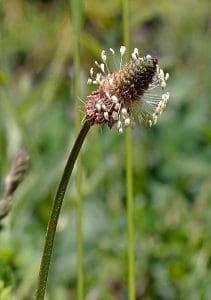
Each flower head can produce up to 200 seeds.
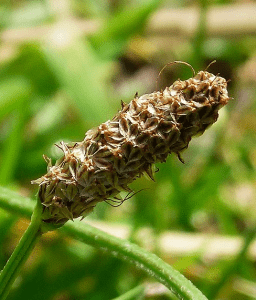
The leaves, flowers and seeds are edible and can be eaten raw or cooked, although the leaves are probably best cooked unless very young, due to those fibrous veins running through them.
The seeds can be ground to a powder and added to flours when baking or just thrown into bakes to add a pleasing crunchy texture to crackers etc.
Both the flowers and leaves taste quite mushroomy and can be boiled to make a mushroom flavoured stock.
This plant has a long history of medicinal uses. It is full of mucilage which is excellent for soothing inflamed mucous membranes and easing chesty coughs. It also contains antihistamine which means it’s effective for treating hay fever and externally for rubbing on Nettle stings and insect bites.
Common Vetch/Spring/Summer/Autumn
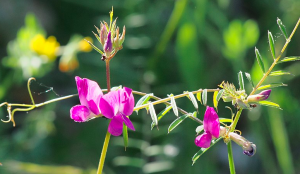
The Latin name for Common Vetch is Vicia sativa. Vicia translates as to curve or bend and refers to the way Common Vetch climbs up and around other plants. Sativa translates as cultivated and possibly refers to the use of Common Vetch as feed for cattle in the past.
If you have ever grown or bought pea shoots then you’ll recognise Vetch if you see it growing along the edges of fields and meadows as the leaves look very similar.
The leaves are compound and are made up of 4-8 small thin leaflets. The leaflets are oval, with a central rib that makes them look as if they are slightly folded. They grow in opposite pairs along the stem. At the end of the stem there is a flexible tendril.
The pink to purple, pea-shaped flowers, are around 10-18mm long and appear on their own or as pairs. The upper petal is often a darker purple with paler coloured wings. It has quite a long flowering period, right through spring and summer.
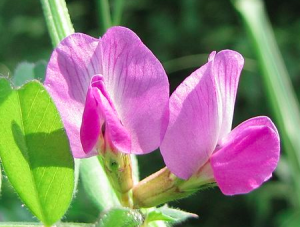
The flowers turn into pea like pods and look like miniature mange tout. They are up to 6cm long and are green and hairy when young, turning almost black as they mature. Inside are up to 12 peas that are green when young, darkening with age.

The leaves and flowers can be eaten raw or cooked. They taste just like fresh peas and are great added to salads.
There are several types of Vetch in the British Isles and some are toxic if eaten in large quantities. They all look quite similar, especially the purple ones. Check your identification carefully before deciding to pick them.
Yarrow/Edible/Spring/Summer/Autumn/Winter

The Latin name for Yarrow is Achillea millefolium, named after the Greek warrior Achilles. It is rumoured that he used this plant to heal his injured soldiers. Millefolium means million leaves and refers to the very many feathery leaves on the plant.
Once you know what you’re looking out for, you’ll easily identify this plant with it’s feathery, almost Fern like leaves and pinky white flower heads.
The leaves alternate along the stem and are evenly distributed. The leaves at the base and middle of the stem are larger than the leaves at the top. They are pubescent, which means hairy and are from 5 to 20cm long. They are arranged spirally on the stem.
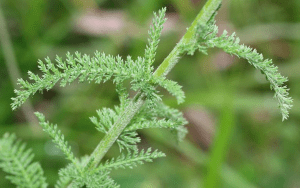
Yarrow has showy flower heads, composed of many tiny tightly packed pinky white flowers, clustered together to resemble umbrellas, rising above it’s ferny foliage.

The leaves can be eaten raw or cooked. They are good in a salad, especially when young. They can be added to soups and stews and have been used as a substitute for hops in the past. The leaves and flowers are very aromatic and make a delicious tea. An aromatic syrup can be made using both the flowers and leaves that can be used to drizzle in cocktails, over ice cream or desserts and splashed in to ice cold sparkling water along with other herbs for a refreshing summer drink.
There are several other brightly coloured cultivated varieties of Yarrow. It’s not clear if these are also edible so perhaps best to steer clear.
Yarrow has a very long history of medicinal uses. It’s a well known plant for stopping bleeding, hence it’s association with Achilles and his wounded warriors. Traditionally the upper parts of the plant were dried and ground to a powder which was carried and applied directly to wounds when out in the field. Yarrow is also anti bacterial so will help fight off any wound infection.
Yarrow is also famous for helping to break a fever and was a popular ingredient in cold and flu tea blends.
A word of caution. Yarrow should be avoided if pregnant or breast feeding and if you are taking blood thinners.
Chickweed/Edible/Spring/Summer/Autumn/Winter
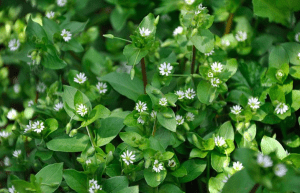
The Latin for Chickweed is Stellaria media, so called because of it’s star shaped flowers, (Stellaria coming from “stella’ or star). Media refers to the flower size, meaning ‘between’, ‘intermediate’ or ‘mid sized’.
Chickweed is a sprawling low growing plant. It forms dense mats of long trailing stems with thin loosely attached roots, making it very easy to remove from the soil.
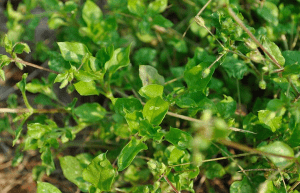
The leaves are in pairs and distributed about 2cm apart along the stems, more clustered around the flower heads at the end of the stems. Between each pair of leaves, a fine spine of hair runs along the stem, starting at an alternate point on the section of stem up to the next pair of leaves.
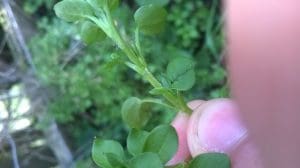
The flowers are white and look like little stars, with 5 petals that have deep divisions in them, giving the appearance of 10 petals.
Chickweed has a high iron content so is an excellent plant to include in your diet if you are suffering from an iron deficiency. It is also used medicinally for skin disorders, respiratory disorders, painful periods and arthritic pain.
Docks/Edible/Spring/Summer/Autumn/Winter
Broad Leaved Dock Curly Dock
There are two main species found in the UK, Broad-leaved Dock (Rumex obtusifolius) and Curled Dock (Rumex crispus) both have a similar taste and can be used in the same way.
The Rumex part of the name possibly comes from both species being used to aid digestion. Obtusifolius refers to the bitter flavour and crispus to the shape of the leaves.
Most people associate Docks with alleviating Nettle stings but they are edible too.
The leaves grow from a central rosette, they are oblong to spear-shaped, smooth and have rounded bases. Deep green in colour, lower and more mature leaves often develop a reddish tinge. As the name suggests Curled Dock has wavy, curled edges to its leaves. Up to 30cm long.
Broad Leaved Dock Curly Dock
The flowers grow at the top of a tough, reddish stem. They consist of large clusters of racemes that contains small greenish flowers that change to red as they mature. The flower spikes often persist over winter.
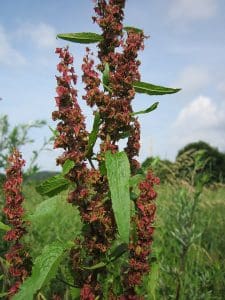
The seeds are papery and dry, when mature they are reddish-brown in colour.
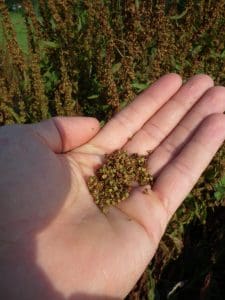
All parts of the Docks are edible and they have been used as food or medicine for centuries. The leaves and shoots have a sharp, lemony flavour similar to Sorrel. They can be used raw in salads or cooked as a leafy green as a spinach alternative. The dried and powdered leaves make a nice seasoning for fish and seafood. The stems are nice to nibble on a walk or they can be chopped, stewed and used as a rhubarb alternative. The seeds can be boiled as a porridge style dish or dried and ground, they can be used as a gluten-free flour. The fresh leaves were used to wrap and preserve butter. After the plant has flowered the leaves and too tough and bitter to use.
Docks are very nutritious. Curly Dock, for example, contains more vitamin C than oranges and more vitamin A than carrots. It also contains vitamins B1 and B2, and iron.
Broad Leaved Dock has been used as a treatment for nettles stings for centuries. Most people reach for the leaves to treat a Nettle sting but it’s actually the base of the leaf stems that are most effective, or more accurately, the paper like casing that new leaves emerge from. Cocooned in this casing the new leaves are held in a clear gel like substance that is often referred to as the UK version of Aloe Vera. This gel will give almost instant relief from Nettle stings and insect bites.
In traditional herbal medicine, they are used as a remedy for staunching bleeding or for purifying the blood. The juice from the leaves can be applied as a compress to heal bruises.
The seeds have been used to treat coughs, colds and bronchitis, and the roots are used as a remedy for jaundice, liver problems, skin ailments, boils, rheumatism, constipation and diarrhoea.
Like rhubarb, docks contain plentiful oxalic acid, which can be a problem for anyone prone to kidney stones.



